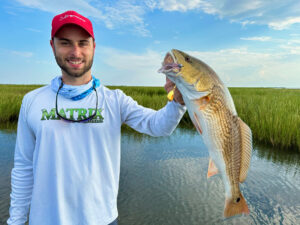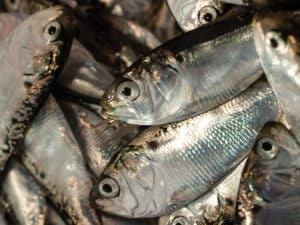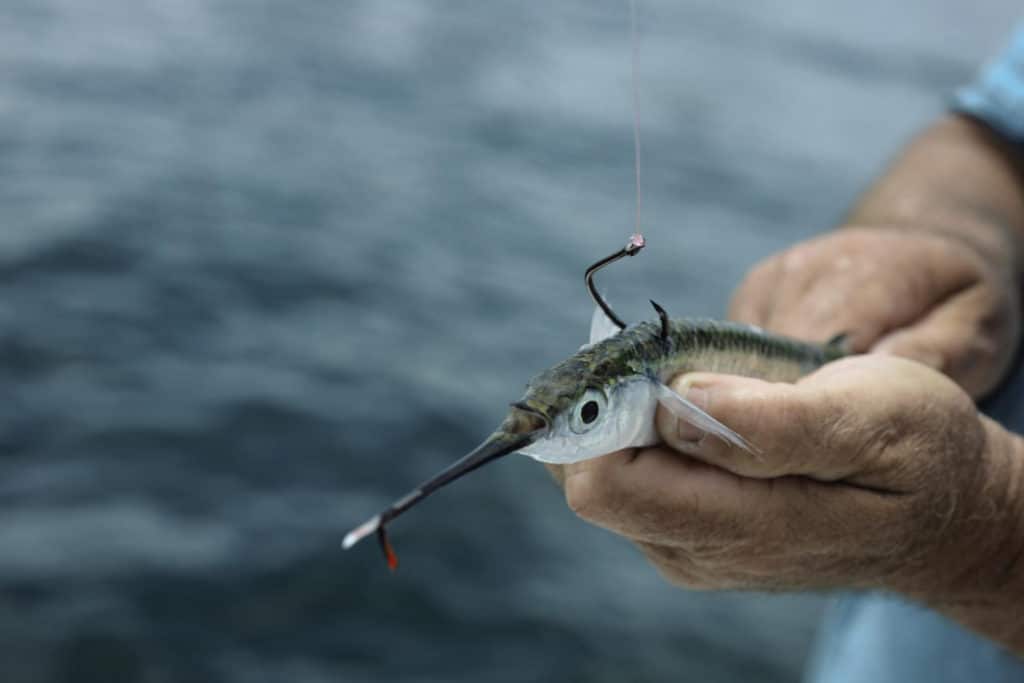
Yellowfin tuna surrounded the boat, exploding off the transom, yet they ignored each lively Pacific sardine I cast. Meanwhile, my longtime fishing buddy, Ron Ballanti, could do no wrong. Each live sardine he cast resulted in a hookup.
“What’s the secret?” I finally asked.
“Hook your bait through the breastplate,” he answered.
I had been hooking them through the nose, making the sardines want to swim back to the boat as soon as they hit the water. Hooking the live fish bait in the breastplate made them want to swim down and away, and that was the secret to getting bit. I followed suit, and the next bait I cast was inhaled by a yellowfin.
Choosing where and how to hook bait not only influences how a live bait behaves, but also how enticing it becomes in the water. To find out the secrets of bait behavior, I talked with veteran captains in the Northeast, South Florida, the northern Gulf and Southern California.
While there’s a plethora of live-bait species available to anglers, with lots of corresponding opinions about how to hook each, these experts picked their favorite four species of live fish baits, sharing here the best way to hook live bait.
South Florida/Keys – Capt. Robert “R.T.” Trosset

Few captains have more experience fishing with live bait than Key West charter captain Robert Trosset, known far and wide simply as R.T.
When chasing species such as amberjack, blackfin tuna, dolphin, grouper, kingfish, mutton snapper and sailfish, Trosset first fills the livewells aboard his Yellowfin 34 center-console, Spindrift, with plenty of bait. His favorite four are ballyhoo, blue runners, pilchards and threadfin herring. Here are his methods for how to hook live bait:
How to Rig A Live Ballyhoo
For slow-trolling, drifting, fishing on anchor in a current, or bottomfishing with ballyhoo, Capt. Robert Trosset breaks off the beak and pins a 6/0 Mustad Ultra-Point Demon circle hook up through the bottom jaw and out the top jaw.
A No. 4 or 6 VMC 9226 BN treble hook through the back just behind the gills causes the ballyhoo to swim away yet stay on the surface when free-lining for kingfish and cero mackerel.
Replace the treble with a 6/0 Mustad Ultra-Point Demon circle hook through the back when fishing for dolphin and sailfish.
AdvertisementA treble hook through the back just forward of the tail gives the bait a slightly different action, which sometimes pays off when the bite slows down.
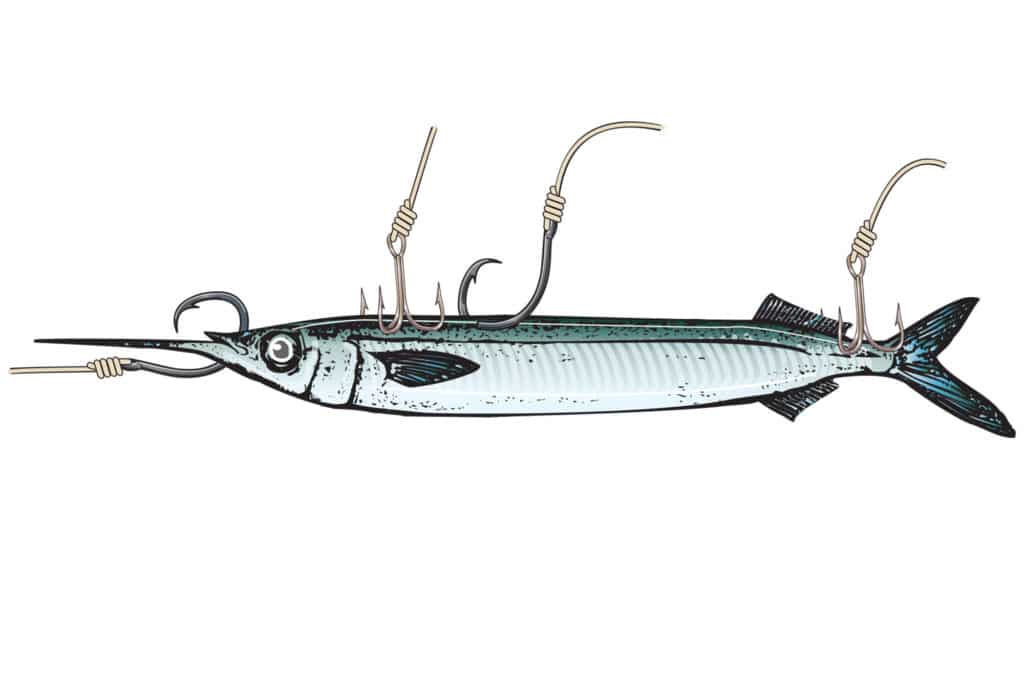
How to Rig A Live Blue Runner (Hardtail)
Pinning the hook through the nostrils works for casting, slow-trolling, drifting or fishing on anchor with current. Use circle hooks such as the 6/0 Mustad Ultra-Point Demon circle hook.
A hook through the roof of the mouth and out the top of the upper jaw is less likely to turn back into the bait, resulting in a better hookup ratio.
A single J-hook such as a 7/0 Mustad 9175 through the back, ahead of the dorsal fin, allows you to troll, drift, bottomfish or use a kite.
For kingfish, use a 4- to 6-inch single-strand, 58-pound-test, brown-colored wire leader connected to the main line with a swivel. To avoid short bites, attach a No. 4 or 6 VMC 9226 treble hook with a short wire trace, and pin one of the points in the back forward of the tail.
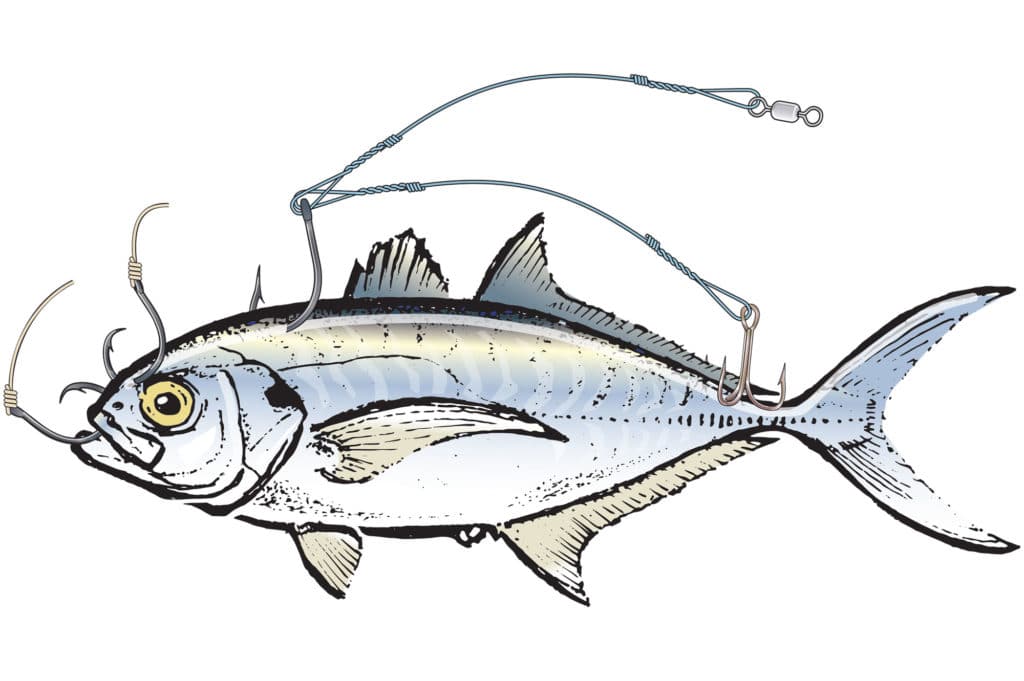
How to Hook A Live Pilchard
When slow-trolling, drifting quickly or fishing on anchor in a strong current, pin the pilchard crosswise through the nose with a 1/0 Mustad Ultra-Point Demon circle hook.
With a light current or drift, hook pilchards through the breast. This causes the bait to swim down about 6 to 8 feet and away from the boat.
Hooking the pilchard through the back, just behind the dorsal fin, keeps the bait upright and splashing at the surface while dangled from a kite.
To make the bait swim away from the boat yet stay close to the surface, hook the pilchard just forward of the tail.
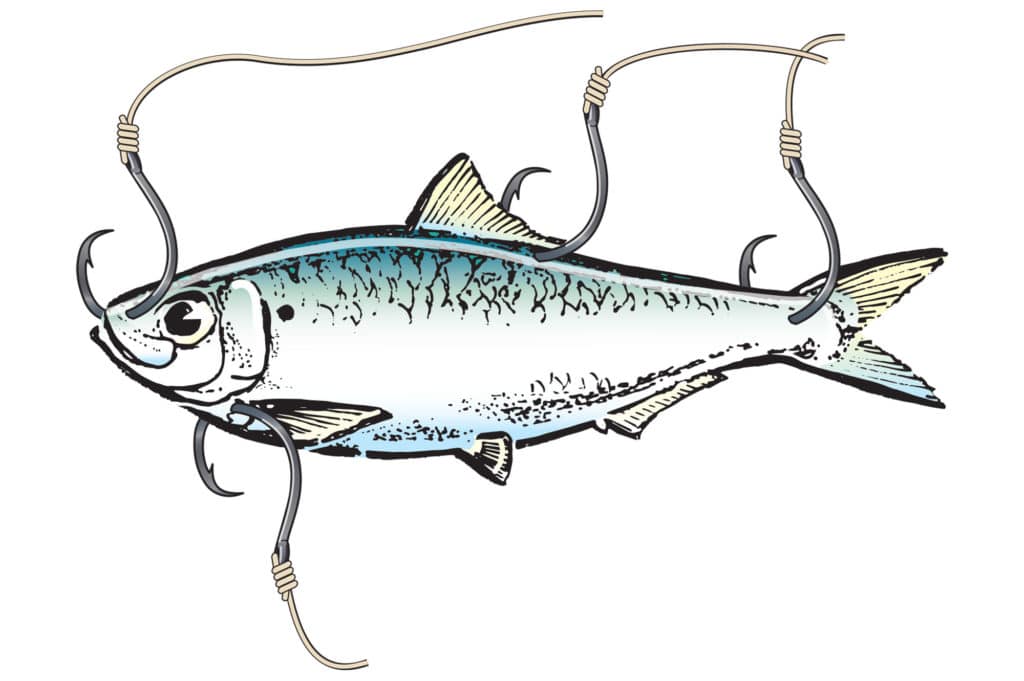
How to Rig A Live Threadfin Herring
Pin the bait sideways through the nose for slow-trolling or fishing a fast drift. Use a Mustad Ultra-Point Demon circle — 3/0 to 6/0, depending on the size of the bait.
When anchored in a current or fishing the bait on a kite, pin the hook lightly through the back, just forward of the dorsal. Substitute a No. 4 or 6 VMC 9226 treble hook and wire leader for kingfish.
Pinning the hook lightly around the anal fin causes the bait to swim away from the boat.
Hooking the bait lightly through the breast will make it swim downward and away from the boat.
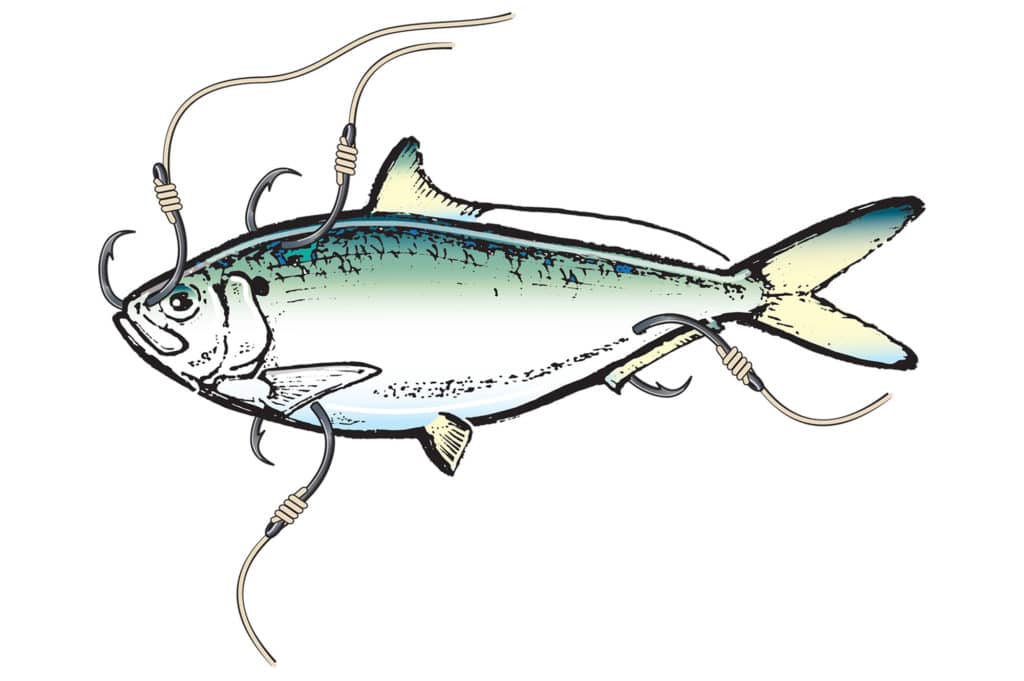
Northeast – Capt. John Raguso

Long Island, New York-based captain-for-hire John Raguso specializes in showing anglers how to find and catch offshore fish aboard their own boats. A big part involves learning how to fish live baits for species such as dolphin, sharks, swordfish and tuna. This skipper’s favorite live baits include squid, menhaden, snapper bluefish and a variety of species of small or juvenile jacks.
Here, he explains how to hook baitfish favorites.
How to Rig Live Jacks
Small bar jacks, juvenile amberjack, and blue runners in the 5- to 8-inch range work well for offshore species such as dolphin, tuna, mako and thresher sharks.
Pin a 5/0 to 7/0 Gamakatsu Octopus J-hook through the roof of the jack’s mouth and out the top of the upper jaw for casting.
To make a bait swim away yet stay near the surface, hook the jack through the back, just forward of the dorsal fin.
Placing the hook through the back, but forward of the tail, causes the fish to swim deep and away from the boat.
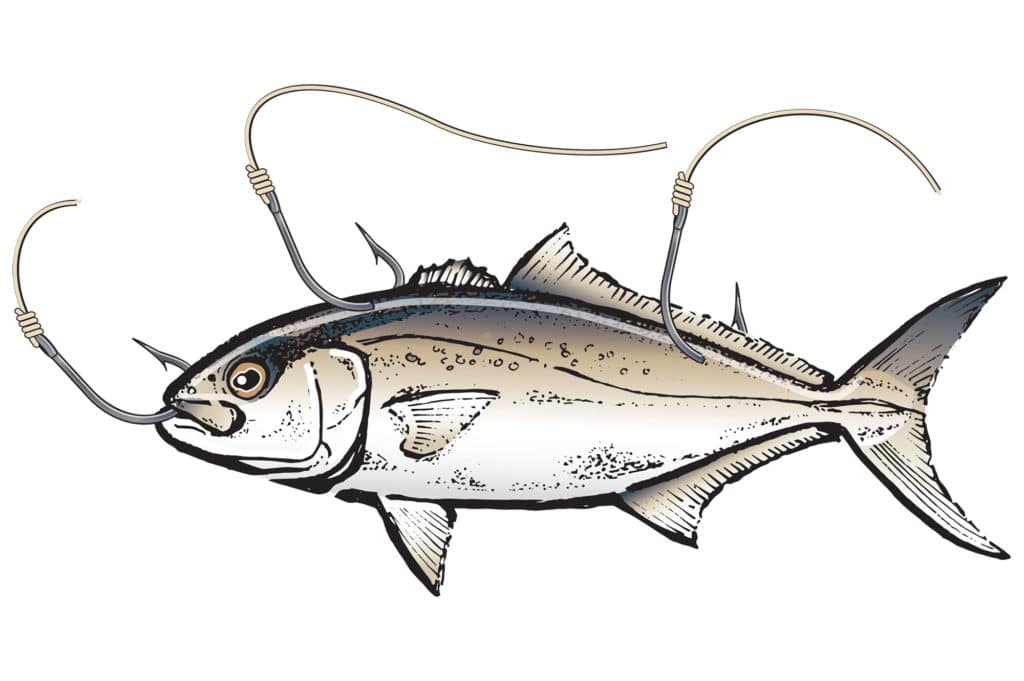
How to Hook Longfin Squid
Squid sometimes show up around a boat while fishing offshore at night, especially if you have underwater lights on. Raguso carries a long-handled net to catch squid, and also uses squid jigs to snare these 9- to 15-inch-long baits.
Use a 5/0 to 7/0 Lazer Sharp Trokar Live Bait J-hook with live squid to catch large offshore fish such as albacore, bigeye tuna, bluefin tuna, dolphin, swordfish, wahoo and yellowfin tuna.
Raguso believes there is only one way to hook these baits — through the tip of the tail, making sure to also put the hook through the internal shell. Hooked in this manner, the squid can be cast, and it tends to fish well in a strong current.
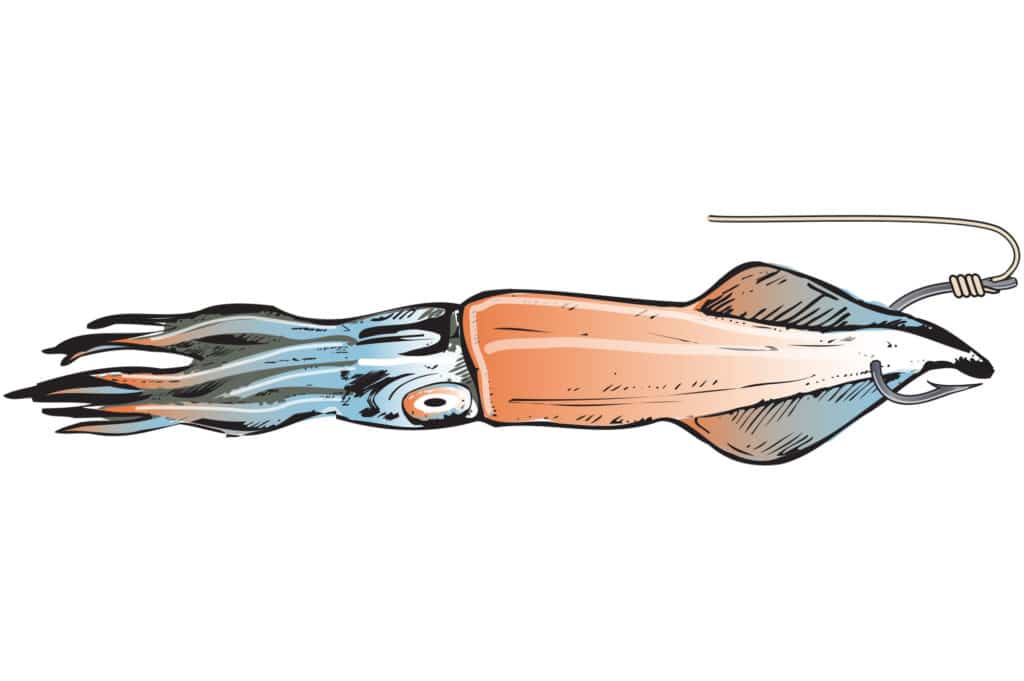
How to Rig Live Menhaden
Menhaden do not fare well in a bait tank, so don’t crowd them. The best baits are 5 to 9 inches, says Raguso.
Hook these baits through the roof of the mouth and out the top of the upper jaw, using a snelled 5/0 to 7/0 Gamakatsu Octopus J-hook for casting.
For wahoo, use a No. 9 or 10 single-strand wire leader with a Gamakatsu Octopus J-hook pinned through the back, with a stinger treble hook rubber-banded to the narrow portion just ahead of the tail.
Pinning the bait with a single J-hook lightly through the back encourages it to swim down and away — an advantage when tuna are feeding deep.
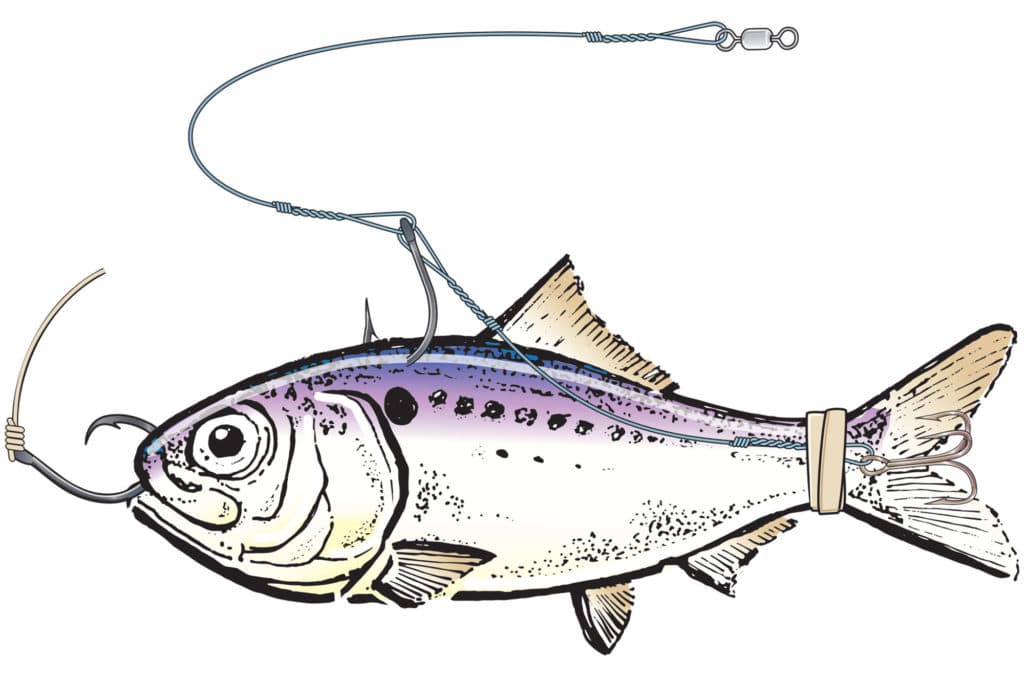
How to Rig Live Bluefish
Snapper bluefish ranging from 4 to 8 inches are hardy and survive nicely in a livewell. They are great for a wide range of offshore fish, including dolphin, sharks and tuna. Here are Capt. John Raguso’s tips for hooking them.
Pin the larger loop of a Duolock snap through the nostrils, with the hook free-swinging inside the snap. This keeps the hook from turning into the bait, and keeps the line out of the snapper’s teeth.
A Mustad Hoodlum J-hook through the back, forward of the dorsal, spurs the bait away from the boat.
Hooking the snapper through the back near the tail makes the bait swim away and downward.
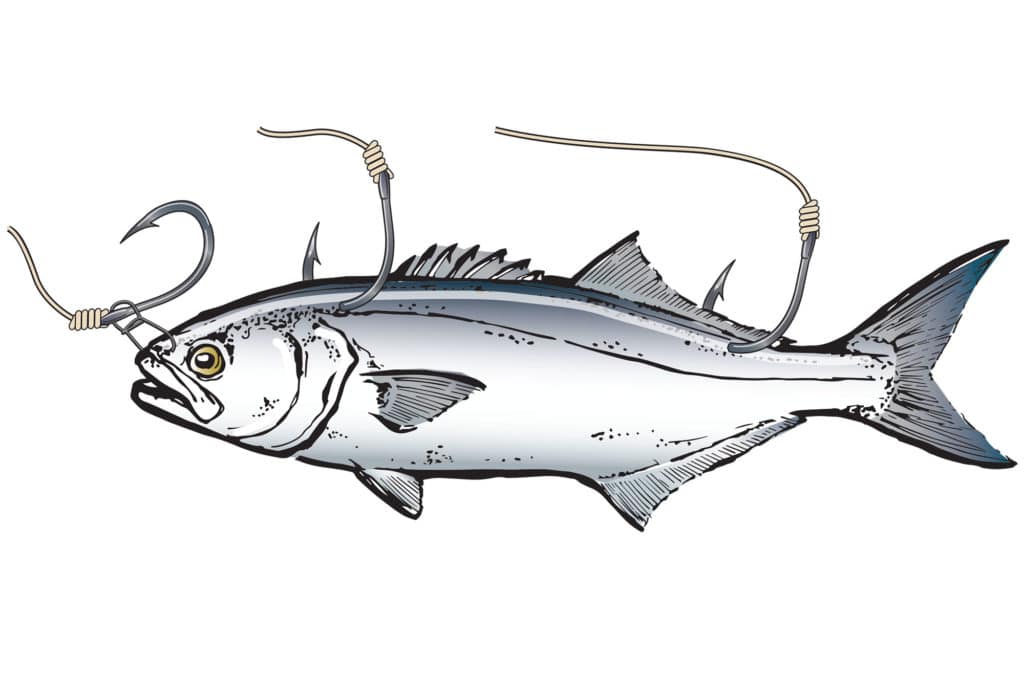
Southern California – Capt. Mark Wisch

With more than 55 years of angling experience off Southern California, Capt. Mark Wisch knows as much as anyone about fishing in this Pacific region, where live-bait fishing originated.
Wisch’s favorite four live baits are also the most common along the section of coast that stretches from Santa Barbara to the Mexican border. He likes northern anchovy, Pacific mackerel, Pacific sardine and opalescent squid.
Here are his methods for how to rig live bait.
How to Live Bait Hook Northern Anchovy
These delicate baits require light-wire hooks such as No. 2 or 4 Owner Flyliners, and are great for Southern California offshore and inshore species. Here’s how Capt. Mark Wisch likes to hook them.
Pinning anchovies sideways through the nose is good for casting, and it allows the bait to live a bit longer in the water.
Hooking the bait through both jaws secures the hook better, but you will need to re-bait frequently, as the anchovy can’t breathe well.
“Collar-hooking” the anchovy through the sinew just behind the upper gill plate makes the bait go away from the boat and toward the side on which you pin the hook.
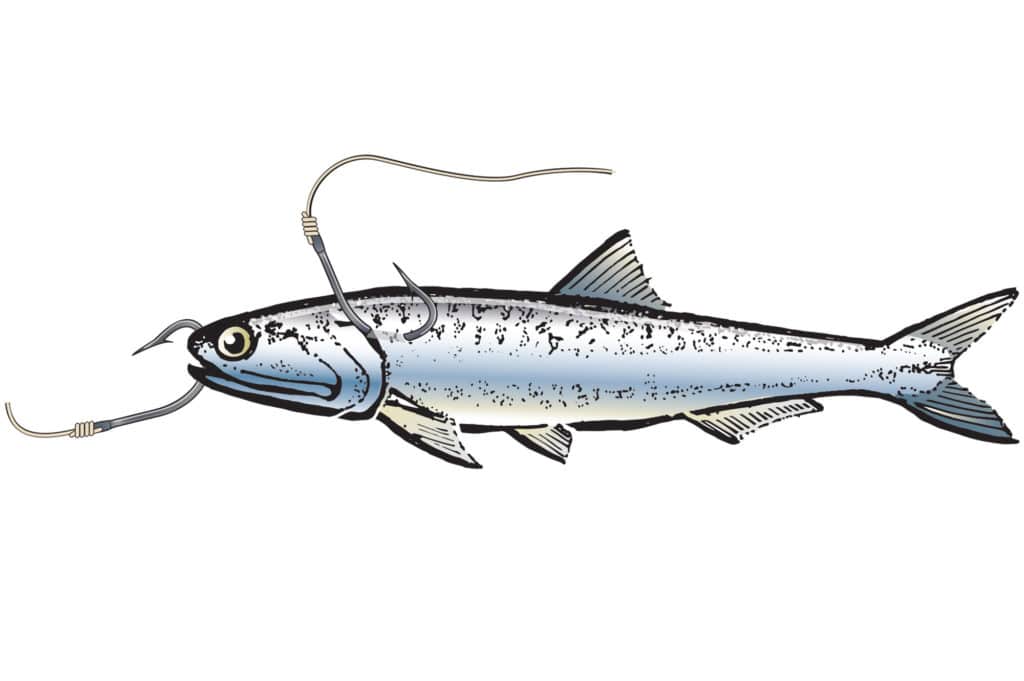
How to Rig Pacific Mackerel
Four- to 6-inch mackerel are great for calico bass, dorado, halibut, tuna and yellowtail, while baits up to 10 inches work well for marlin, swordfish and sharks.
Pin a 4/0 to 6/0 Owner Gorilla hook through the roof of the mouth and out the top jaw for casting, slow-trolling and drifting.
A hook through the back in front of the dorsal works well for sight-casting for marlin and fly-lining for yellowtail.
Placing the hook just forward of the anal fin makes the bait swim down and away from the boat.
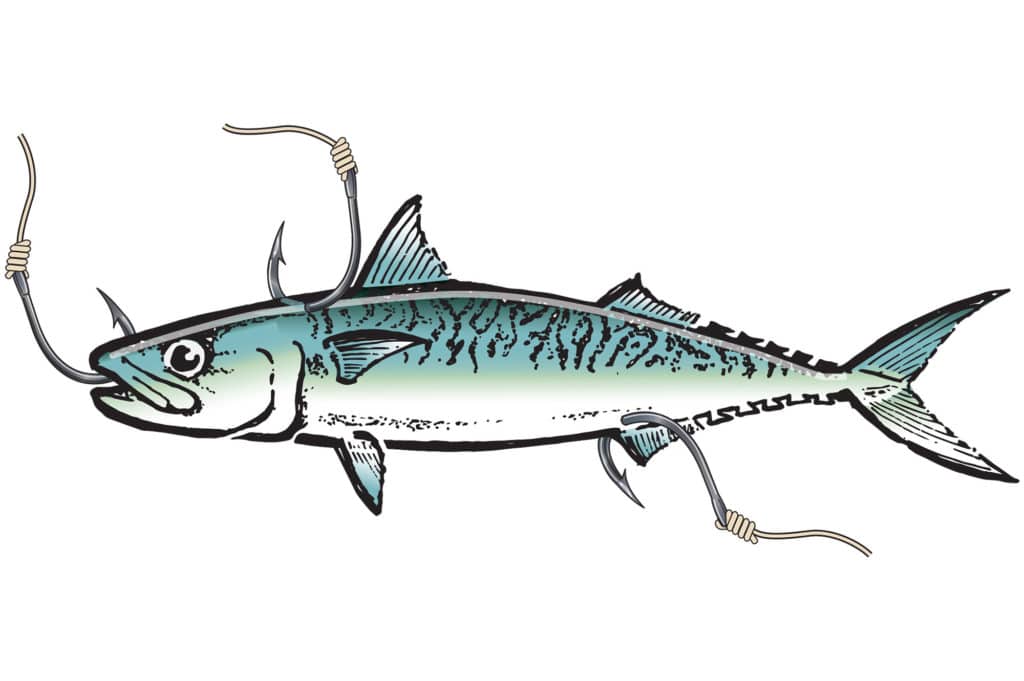
How to Rig Pacific Sardine
Ranging from 3 to 10 inches, Pacific sardines are one of the common live baits in this region. Use an Owner Mutu ringed circle hook for tuna, and an Owner Gorilla Light for other game.
Pin the hook through the nose for casting, drifting and slow-trolling.
A hook pinned lightly though the back, a bit forward of the dorsal fin, works well for slow-trolling and reduces the number of turned hooks.
Placing the hook through the breastplate makes the bait swim out and away. It also pulls out easily for better hook-sets.
“Heart-hooking” through the back of the gill, through the heart and out the side sends the sardine into a frenzied deep dive that drives predators crazy, but the bait lives for only about 30 seconds.
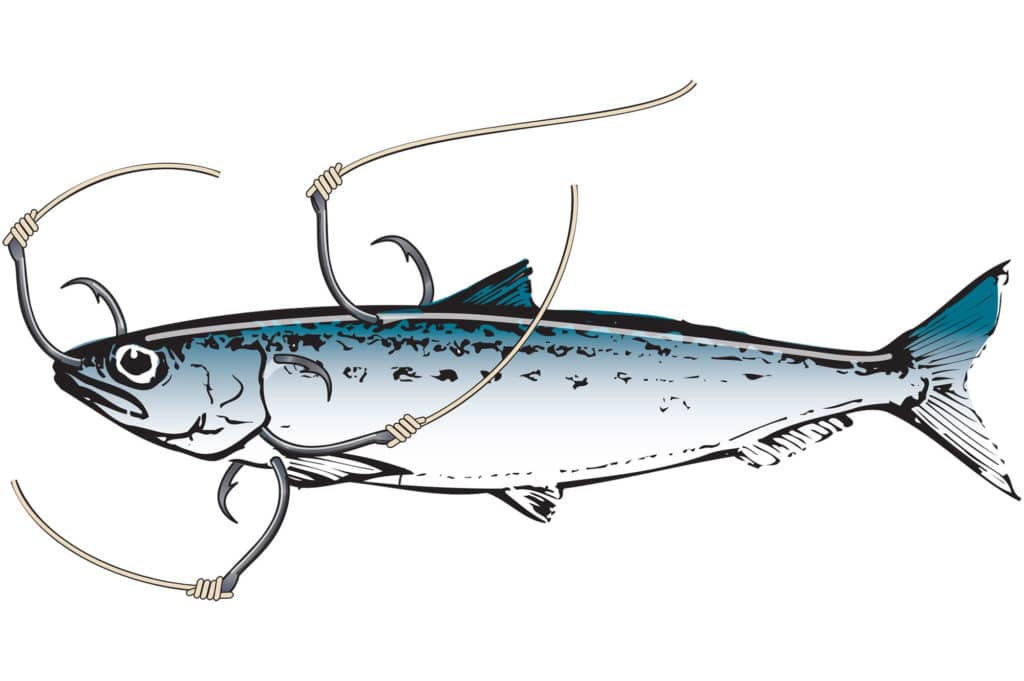
How to Hook Opalescent Squid
For casting and fishing squid on a dropper loop for white seabass, pin an Owner 3/0 to 7/0 Aki Twist hook one time through the tip of the tail. Make sure the hook pierces the internal shell.
Thread the squid on worm-style to help hide the hook when species such as yellowtail are hesitant to bite.
Hooking the squid twice through the middle of the mantle works well when fishing on anchor for calico bass and rockfish.
Placing the hook under and out the back of the mantle can help when you’re experiencing short bites, as fish usually attack the squid’s head first.
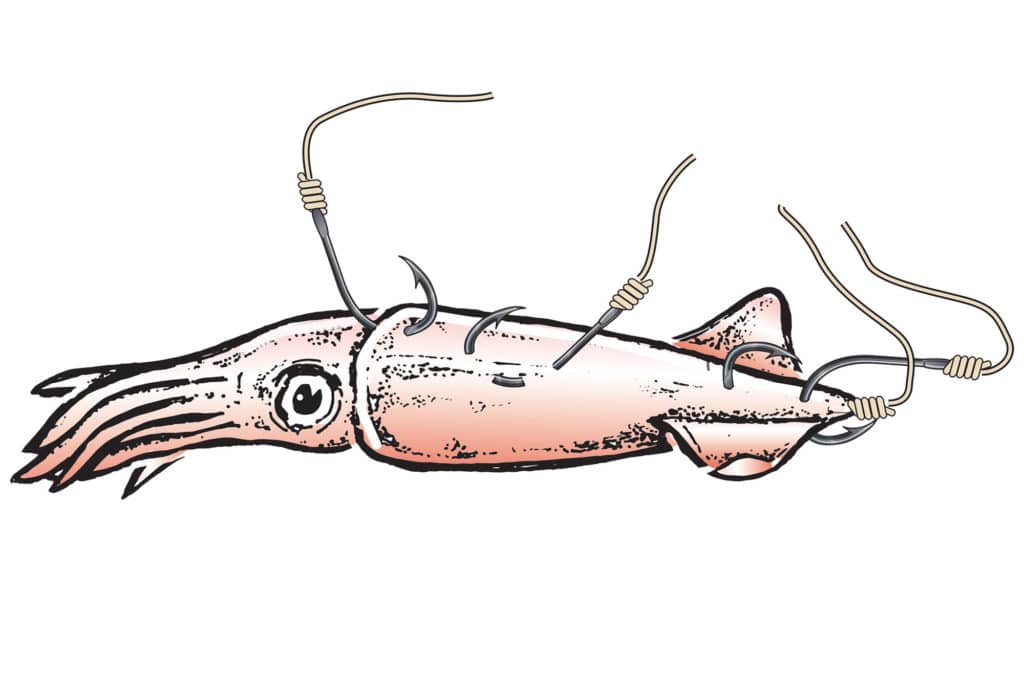
Gulf Coast – Capt. Tommy Pellegrin

With nearly three decades of experience fishing the rigs and marshes of Louisiana, charter captain Tommy Pellegrin has used just about every bait species that exists along this legendary Gulf Coast.
Yet his favorite four live baits aboard his Houma-based 39-foot Gravios pilothouse, Reel Life, are blue runners, croakers, shrimp and threadfin herring.
Here’s how he hooks these live baits.
How to Hook Blue Runner
Capt. Tommy Pellegrin has a unique method of hooking blue runners and other baits that minimizes harm to the fish.
Pin a snelled 8/0 Mustad Ultra-Point Demon circle hook through the soft spot under the lower jaw and then out through a soft spot in the cheek.
For fishing deep, pin the hook through the back just forward of the dorsal fin.
When targeting amberjack, clip the tail fins to make the bait easier for fish to catch.
Don’t clip the tail when fishing for yellowfin tuna, because you’ll want as much action as possible.
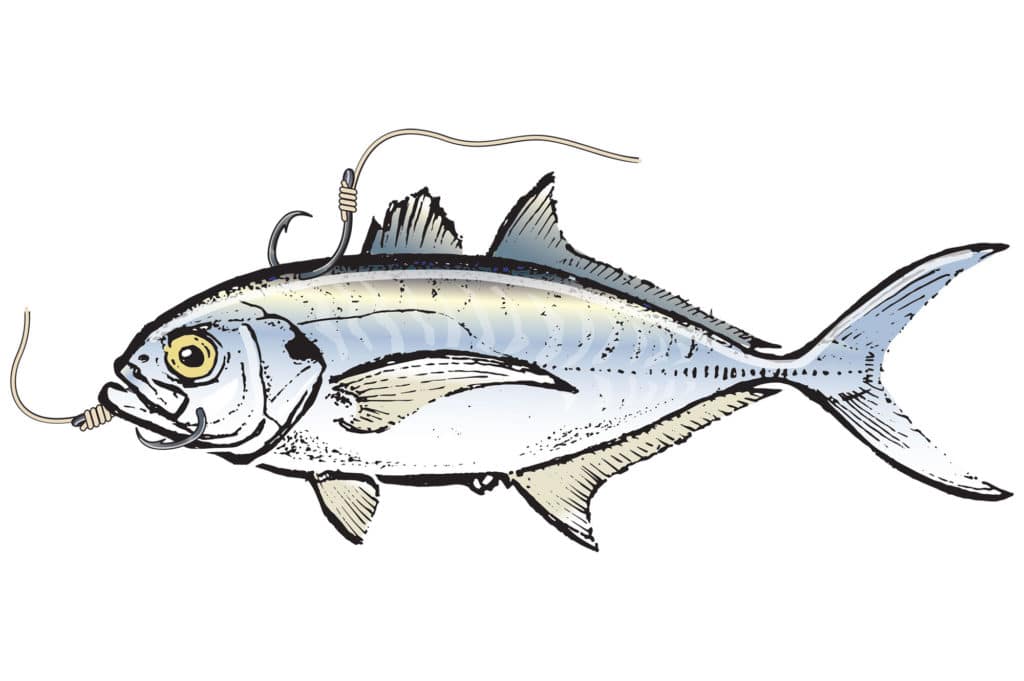
How to Hook Live Croaker
Three- to 5-inch croakers are Pellegrin’s favorite bait for mangrove snapper around oil rigs.
Pass a snelled 3/0 to 4/0 Mustad Ultra-Point Demon circle hook through the soft spot under the jaw, into the mouth and out the soft spot in the croaker’s cheek.
When there is no current, try pinning the hook lightly through the back just ahead of the dorsal fin. This will make the bait swim away from the boat.
For spotted seatrout, pin one hook of a snelled No. 3 Mustad KVD light-wire treble hook in front of the dorsal, and drift the croaker on a sliding cork rig set to fish the bait about 2½ feet off the bottom.
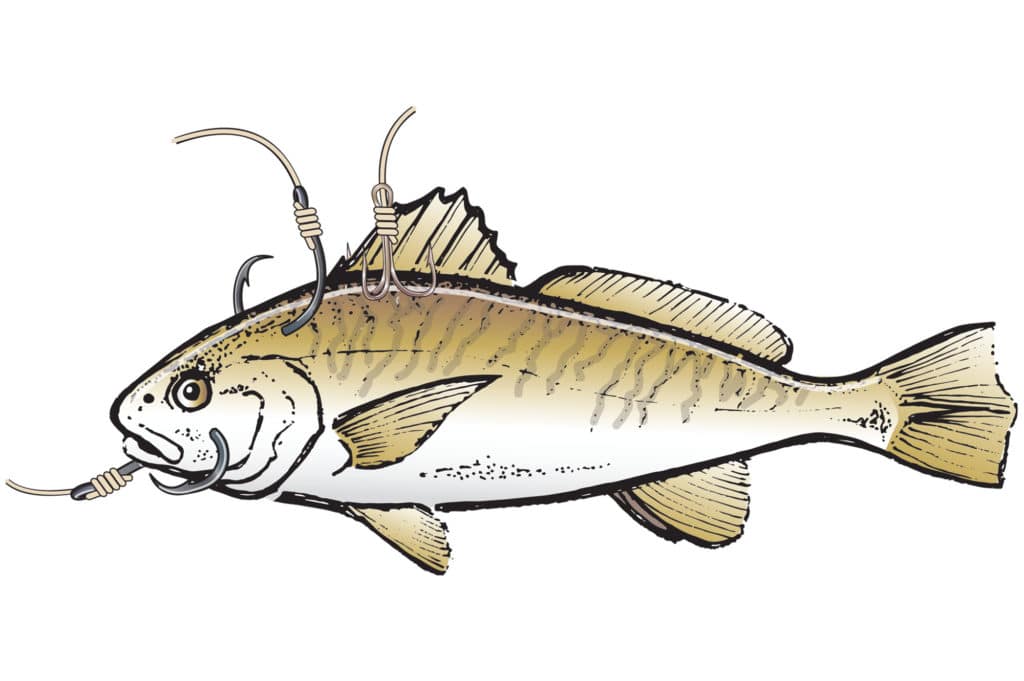
How to Hook Live Shrimp
Pellegrin’s favorite for spotted seatrout is live shrimp, fished on a sliding cork rig set to drift the bait 2 ½ feet off the bottom.
Pin one hook of a snelled No. 3 Mustad KVD light-wire treble hook in the shell in the segment just before the tail. Avoid hooking too much of the meat.
As an alternative, pin one hook of the same style treble through the shell near the smallest black spot between the horns.
Avoid puncturing the shrimp too deeply or piercing the meat.
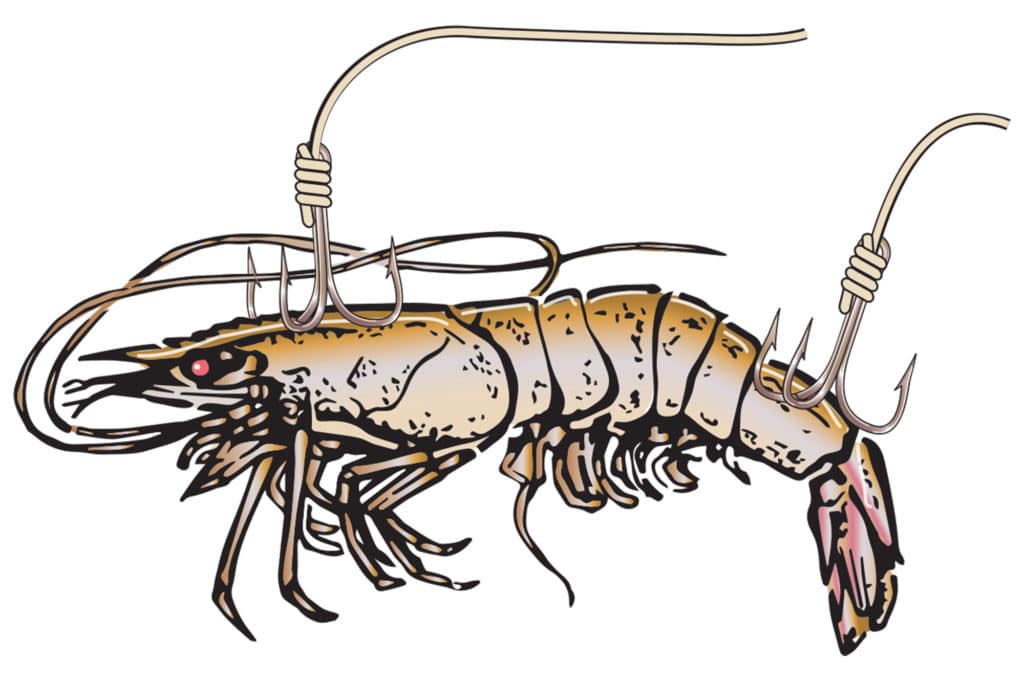
How to Rig Live Threadfin Herring
Ninety percent of Capt. Tommy Pellegrin’s tuna fishing is with threadfin herring, which he describes as very fragile. Here’s how he hooks them.
Pin a snelled 6/0 Mustad Ultra-Point Demon circle hook through the eye socket. This is less damaging to the bait than hooking it through the nose. It lets you slow-troll and drift the bait.
Hooking the fish lightly under the skin in the middle of the back makes the bait swim away from the boat. If a bait doesn’t get bit right away when tuna-fishing, replace it quickly with a fresh bait.
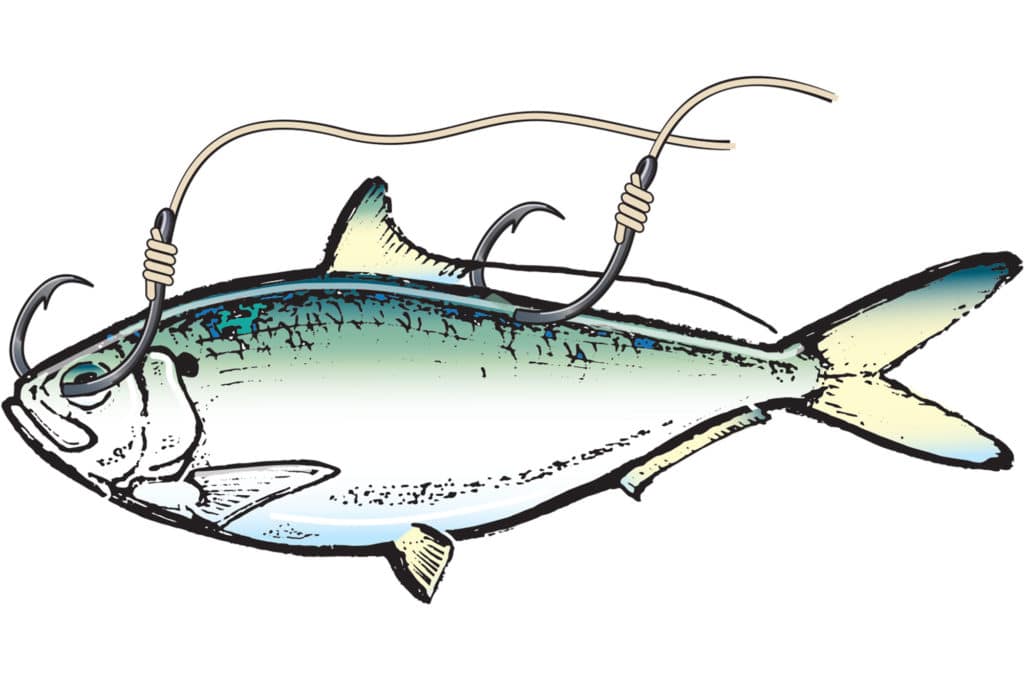
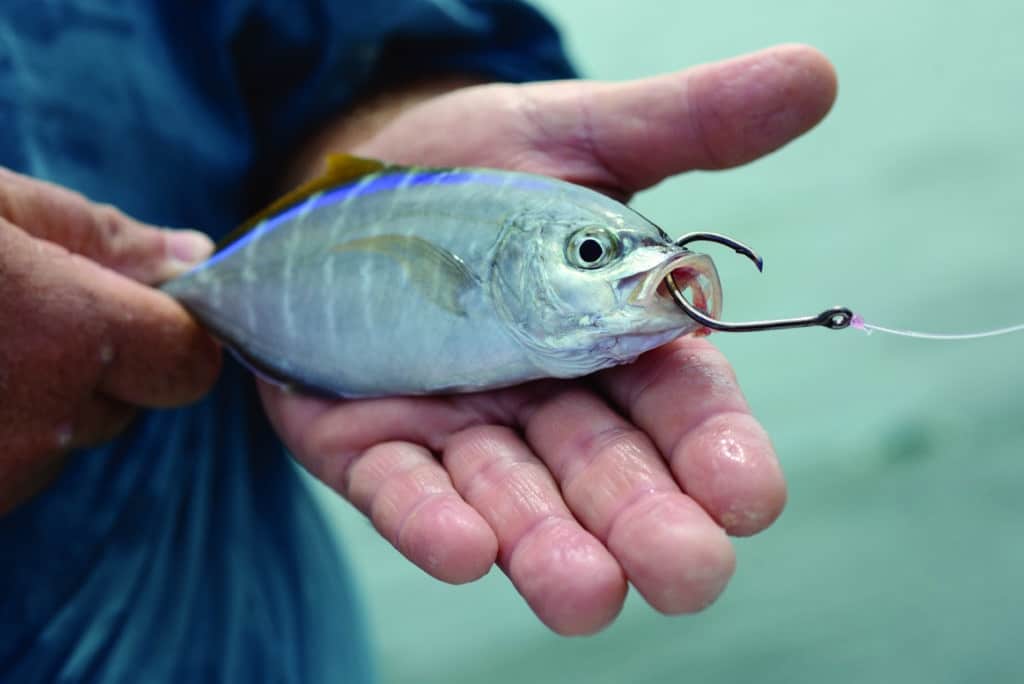
Try Using Other Live Baits for Fishing
Don’t be afraid to try live baits different from what our experts outline here. The feeding habits of fish change all the time, and the bait that was hot last week might not produce at all today.
One great option in the southeast United States is a frisky live finger mullet. In the Gulf during the mullet runs, for example, species such as tarpon and snook key in on this common bait species. And in Southern California, anglers have discovered recently that sand dabs — small flatfish — are outstanding live baits for lingcod and other bottom fish.
Also experiment with hook placement, especially if you are missing fish when they bite. As Capt. John Raguso pointed out, putting the hook through the roof of the mouth (versus sideways through the nose) reduces turned hooks and increases the hookup ratio.



